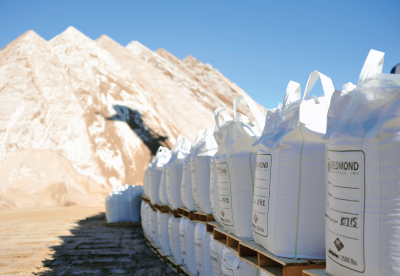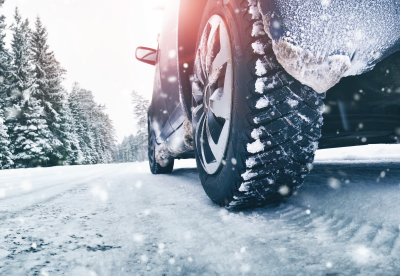Date November 20, 2024 | Brooke Loeffler
Winter Tires vs. All Season Tires
All Season Tires, Winter Tires, and Studded Snow Tires...What's the Difference?
Walking into a tire store, you can see a vast array of options to choose from. There are a few basic categories to understand before you make a purchase. And remember, within each of these groups there is a spectrum of performance abilities (talk to your tire supplier to make sure you understand your options).

All Season Tires
All season tires are intended to span a range of wet and dry weather conditions, but not temperature ranges. Below 45° F, the rubber compound can stiffen, and lose its ability to flex and grip the road surface.
If you live in a place that only experiences cold temperatures under freak weather condition's, these tires will work well for you year round. If you reliably see snow and sub-freezing temperatures at home, your all season tires should be switched out during the winter months.
Winter Tires
The best winter tires are typically made with rubber compounds that remain flexible even in colder temperatures. Their treads are formed by sharper and more irregular edges to increase your vehicle’s grip in snowy, icy, and slushy conditions. On these tires, you will also see additional sipes (or slits) in the treads that increase traction.
Studded Snow Tires
If you live in an area that experiences frequent, heavy snow and ice, then studded snow tires may be right for you. In fact, in some areas, they are required. These tires have all the same tread design benefits as winter tires, but are also equipped with metal studs to increase gripping traction. Studded snow tires are not intended to be used on bare or dry roads. Not only will you quickly wear down your metal studs, you will also cause unnecessary damage to your driveway and the road surface.
Mountain Snowflake Icon
Back in 1999, the United States Tire Manufacturers Association (USMTA) began using a side wall brand to identify winter rated tires. These tires meet the ASTM traction tests on packed snow. The icon can appear on a wide range of tires, so be sure to ask your tire supplier about the performance ranges so you choose the best tire for your local conditions.
What Increases Traction in the Snow?
Click here to learn more about road friction (traction).
Flexibility
Modern tires only contain a small percentage of natural rubber (mostly around 10%). This rubber is combined with different polymers and fillers depending on how the tire will be used (ie. racing tires will have a much different composition than road tires). As mentioned above, not all rubber compounds are created equal. Winter and snow tires are composed of materials that are more elastic and give you more flexible grip on slick surfaces.

Tread Design
Just like a gecko’s foot, the grooves, slots, and sipes in a tire’s tread are meant to splay open and grip slippery surfaces. Computer technology helps tire manufacturers create tread models with more irregular edged features to increase traction. They will also incorporate deeper groves to increase a tire’s ability to expel slush and snow away from your vehicle. As time goes on, tire treads continually become more intricate to improve safety and overall driving experience.
Winter Tire Maintenance
As with all winter preparations, do not delay research and purchase decisions. You will have a wider selection, and better luck beating the crowds if you purchase your winter tires early.
When Should I Make The Switch?
As a general rule, you should switch to winter tires when your local conditions are consistently under 45° F. Some vehicle manufacturers may have more specific guidelines, so please refer to your vehicle’s manual for more targeted advice on when to switch to winter tires. In addition, there are certain areas where winter tires are mandatory. Be sure to familiarize yourself with your winter driving routes and have winter tires installed before you try and drive through those areas. Also, make sure you always install a complete set.
How To Store Tires
Clean your tires and dry fully before storing them during non-use. Tire rubber compounds can dry out and become brittle, so be sure to store your tires in large, water proof, opaque, and durable bags (ie. lawn and leaf or contractor bags) during the off season. Remove excess air from the bag and seal them up to keep your tires flexible and ready to use. If possible, stack and store tires indoors. If no indoor storage is available, make sure they are kept away from heat and excess moisture to extend the life of your tires.
Checking Tire Pressure
Temperature fluctuations change the pressure of gases, including the air inside your tires. Keep a tire pressure gauge in your vehicle to help you make the necessary adjustments to your tires throughout the winter. If you do not have an air compressor at home to fill your tires, find your closest service station with an air pump so you know where to turn when you need a top off.
Measuring Tread
 If you do not have a tire tread gauge, a penny will do. Simply place the edge of the penny into your tire’s tread. If Lincoln’s head is covered by tread, your tire’s still have plenty of use in them. If Lincoln’s head is entirely visible, then it is time to replace your tires. Be sure to test your tires as you pull them out of storage so you don’t put threadbare tires back onto your vehicle.
If you do not have a tire tread gauge, a penny will do. Simply place the edge of the penny into your tire’s tread. If Lincoln’s head is covered by tread, your tire’s still have plenty of use in them. If Lincoln’s head is entirely visible, then it is time to replace your tires. Be sure to test your tires as you pull them out of storage so you don’t put threadbare tires back onto your vehicle.
To really boost your traction on your driveway and walkways, add Ice Slicer® Nature's Blend to your winter safety arsenal! For more handy winter driving tips, click to get our Winter Road Guide.
© 2024 Redmond Minerals Inc.






